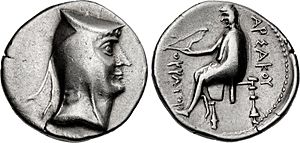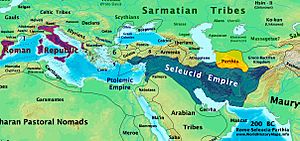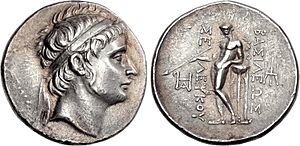Arsaces I of Parthia facts for kids
Quick facts for kids Arsaces I𐭀𐭓𐭔𐭊 |
|
|---|---|

Coin of Arsaces I. The reverse shows a seated archer carrying a bow, with the Greek legend reading "ΑΡΣΑΚ[ΟΥ]" (right) and "[AYT]OKPATOP[OΣ]" (left), meaning "Arsaces autocrator".
|
|
| King of the Arsacid dynasty | |
| Reign | 247 – 217 BC |
| Successor | Arsaces II |
| Died | 217 BC Parthia |
| Issue | Arsaces II |
| Father | Phriapites |
| Religion | Zoroastrianism |
Arsaces I (/ˈɑːrsəsiːz/) was the first king of Parthia. He ruled from 247 BC to 217 BC. He also founded the Arsacid dynasty of Parthia. Arsaces was the leader of the Parni, a tribe from the Dahae group. He started his dynasty in the mid-3rd century BC. He did this by taking over the region of Parthia from Andragoras. Andragoras had rebelled against the Seleucid Empire.
Arsaces spent his rule making his power strong in the area. He successfully stopped the Seleucids from taking Parthia back. Because of his successes, Arsaces became a very important figure. Later Arsacid kings used his name as a special honor. By the time he died, Arsaces had built a strong state. This state later became a large empire under his great-grandnephew, Mithridates I. Arsaces was followed by his son Arsaces II.
We don't have many old writings about Arsaces. The few we have are from Greek and Roman sources. These were written hundreds of years after he died. For a long time, some modern experts even doubted if he really existed. But new studies and discoveries in the 1960s proved he was real.
Contents
Who Was Arsaces?
The name Arsaces comes from the Greek Arsákēs. This name itself comes from the Parthian word Aršak. The name means "hero" in an older Iranian language. This name was also used by some rulers of the Persian Achaemenid Empire. The Arsacid kings saw themselves as connected to these earlier Persian rulers.
Stories about Arsaces are different depending on where they come from. Greek and Roman writers often didn't like him or his family. This was because of later wars between Rome and Parthia. In Iranian history, his family line is linked to old mythical heroes. Some stories say he was a bandit who took over Parthia. He killed its governor, Andragoras.
The most accepted idea comes from the Greek writer Strabo. He said Arsaces was a Scythian or a leader from Bactria. He became the chief of the Parni tribe. The Parni were part of the Dahae group from Central Asia. The Dahae were very strong on horseback. This made them hard to control for other empires.
The Dahae tribes first lived near the Syr Darya river. Over time, they moved south. They settled in Parthia, an area near the Caspian Sea. This region was then ruled by the Seleucid Empire. The Parni were an eastern Iranian tribe. They had their own old Iranian beliefs. But by the mid-3rd century BC, they had become part of the local Parthian culture. They started speaking Parthian and followed the Zoroastrianism religion. Arsaces' father, Phriapites, even had a Zoroastrian name. Arsaces himself was likely born and grew up in Parthia. He probably spoke the Parthian language.
The Dahae often worked as horse archers for Greek rulers. This included Alexander the Great and Antiochus III the Great. This suggests that Arsaces, who was called an "experienced soldier," might have worked as a soldier for the Seleucid rulers.
Arsaces' Rule

Around 250 BC, Arsaces and his Parni followers took control of Astauene. This area was near the Atrek valley. A few years later, around 247 BC, Arsaces was crowned king in Asaak. He had founded this city. His crowning at Asaak is seen as the start of the Arsacid dynasty.
Around 245 BC, Andragoras was the governor of Parthia for the Seleucids. He declared his independence from the Seleucid king Seleucus II Callinicus. This made his area an independent kingdom. After Parthia broke away, Andragoras found it hard to protect his borders. Around 238 BC, Arsaces and his brother Tiridates I led the Parni to invade Parthia. They took control of Astabene from Andragoras. Soon after, the Parni took the rest of Parthia and killed Andragoras. After taking this area, the Arsacids became known as Parthians. The nearby region of Hyrcania was also taken by the Parni.
In 228 BC, Seleucus II tried to get Parthia back. This was a problem for Arsaces. He was also fighting the Greco-Bactrian ruler Diodotus II at the same time. To avoid fighting two wars, Arsaces quickly made peace with Diodotus II.
However, Arsaces could not stop the Seleucid army. He had to leave Parthia and go to Central Asia. He found safety with the Apasiacae tribe. But the Seleucid control of Parthia did not last long. Seleucus II had problems in other parts of his empire. He had to leave Parthia. This gave Arsaces a chance to get his lands back. He likely expanded his rule even further south. Arsaces also made an alliance with the Greco-Bactrians. This shows they had likely been in contact for a long time. The Roman historian Justin wrote that Arsaces "settled the Parthian government, levied soldiers, built fortresses, and strengthened his towns." Besides Asaak, he also founded the city of Dara. Nisa, also founded by Arsaces, became the royal home for the Arsacids until the 1st century BC.
Who Ruled Next?
For a long time, it was unclear who followed Arsaces as king. Some believed that Arsaces and his brother Tiridates started the dynasty together. They thought Tiridates became king after Arsaces died. This led to ideas that Arsaces might have been a made-up person.
But between 1957 and 1962, a scholar named Józef Wolski argued differently. He believed Arsaces was the true founder. He thought Tiridates was a made-up character. This idea was later proven right. An ancient clay tablet (called an ostracon) found in Nisa had Arsaces' name on it. Also, studies of old coins and other writings showed that Tiridates was not real. These findings confirmed that Arsaces ruled until his death in 217 BC. His son, Arsaces II, then became king.
Arsaces' Coins
Arsaces' coins set the style for all later Arsacid coins. His coins took ideas from Seleucid coins and older Persian coins. But he also added new things that made them unique. On his coins, Arsaces purposely made them different from Seleucid coins. He wanted to show his own power and royal goals.
Instead of the Greek god Apollo holding a bow, Arsaces' coins show an archer. This archer looks like Arsaces himself. He sits on a stool, like some old Persian governors. He wears Scythian clothes and a soft cap called a bashlyk.
Some of the words on Arsaces' coins call him kārny. This was a title used by important Persian military leaders. By using this title, Arsaces showed he was more than just a governor. But he avoided using the Greek royal title of basileus (king). This showed he did not follow the Seleucid way of ruling.
Arsaces likely used the city of Nisa, which he founded, to make his coins. He made coins from both silver and bronze. His silver coins, called drachms, show his face without a beard. He looks to the right, similar to how Seleucid kings were shown on coins. The archer on the back of the coin faces left. The Greek words "ΑΡΣΑΚΟΥ ΑΥΤΟΚΡΑΤΟΡΟΣ" are written on the sides of the coins. Even with these similarities, Arsaces' coins are clearly from a non-Greek ruler. For example, Arsaces wears a pointed soft cap on the front. The archer on the back wears Iranian riding clothes.
Arsaces' Lasting Impact

Arsaces was remembered long after he died. More than 200 years later, a special fire in his honor was still kept burning in the city of Asaak. This shows that crowning a king had a religious meaning. This fire was likely the special fire of the Arsacid family. It probably showed that they were the rightful heirs to the Achaemenid Empire.
Because of his achievements, Arsaces became known as the "father of the nation." His name became a royal honor used by all Arsacid kings. This was a sign of their respect for him. The name also linked the Arsacids to an old legendary ruler named Kavi Arshan. From the 2nd century BC, the Arsacids also claimed that Arsaces was a descendant of the Achaemenid king, Artaxerxes II.
Arsaces' family ruled for 450 years. They were finally overthrown by the Sasanian Empire in 224 AD. But even after that, Arsaces' descendants still had a lot of power. One important family, the House of Karen, produced many famous people in Iranian history. The Arsacids also played a big part in the history of the Caucasus region. Areas like Armenia, Caucasian Albania, and Iberia were ruled by branches of the Arsacid family. Even in the 6th century, Armenian nobles still remembered their Arsacid heritage and Arsaces himself.
See also
 In Spanish: Arsaces I para niños
In Spanish: Arsaces I para niños




